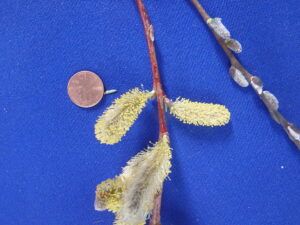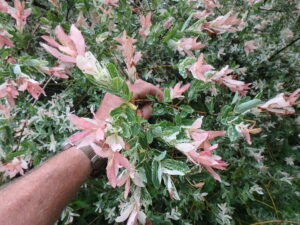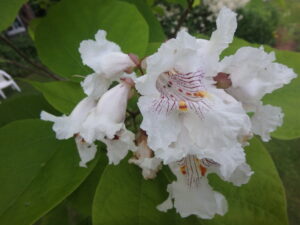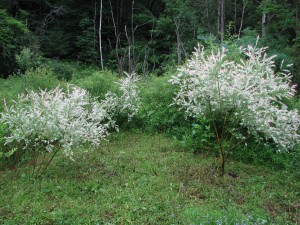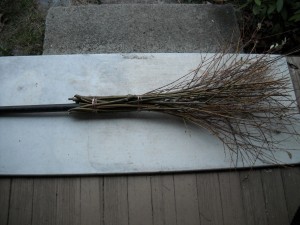Pollen, Allergies and Plants
If you suffer from spring allergies, this would be a good time to know what plants are affecting your comfort. Right now, many trees are dumping their pollen. Most trees are wind pollinated and produce lots of pollen. They depend on the wind to move pollen around – and up your nose.
Although some trees and shrubs produce both male and female flowers, many are dioecious, meaning that male and female flowers are on separate plants. It is thus to their advantage to produce their (insignificant-looking) flowers and lots of pollen before the leaves get in the way. Which for me, is right now. Showy flowers do not necessarily mean that trees like catalpa are low on the aggravation index (they are rated 8 of 10 on the index), but others like magnolias are lower. Both of those are pollinated by insects.
Very popular in the landscape industry right now is the ‘Hakuru nashiki’ willow. It has tri-colored (green, white and pink) leaves in June, and is sold either as a multi-stemmed shrub or as a “standard”. Standards are created by grafting branches on the top of a straight, bare-of-branches stem that is generally about 4 feet tall. As far as I know, Hakuru nashiki willows are all female, so they do not create those fuzzy “pussies” and pollen.
After the trees do their thing, along come the grasses. The seven worst offenders are introduced species of grass, including orchard grass, blue grasses and timothy grass, which is commonly grown for animal feed. Grasses are wind pollinated, and their pollen can float long distances. Your lawn should not be a problem so long as you never let the grass get tall enough to blossom. But fungal spores in the lawn can cause allergic reactions, and can be stirred up by mowing, so if you get hay fever, you have a good excuse to get your spouse or kid to do the mowing.
How to Create a Secret Space for Children
My sister Ruth Anne and I spent a lot of time on my grandfather’s farm in Spencer, Massachusetts when we were young. Grampy grew the most fabulous cukes, carrots and tomatoes – and flowers that would almost make the “faint of heart” swoon. I loved my time there.
One of the best features, on a hot afternoon, was a huge oval of forsythia bushes that enclosed a space where we could hide from adults and stay cool. I recently re-created such a space for my grandkids.
Kids like to have places that are secret and private. These days “helicopter parents” are said to be the norm. Even if you are not one, you might want to grow plants that will allow you to be nearby in case of emergency, but allow children the semblance of privacy.
So here is what I did: I planted 3 fast-growing willows about 10 feet apart. The one I planted is called ‘Hakuru-Nashiki’. At this time of year the leaves have pinkish tips, with white and green on them. Each of my shrubs had 3 stems when I bought it, and grew taller and wider each year. Now, 10 or more years later, they form a single mass of foliage about 15 feet tall. But the center of the planting is rather empty – a perfect place to make a “kid’s cave”.
To start, I entered the thicket, pruners and loppers in hand. I removed anything dead, or anything that was a potential “eye-gouger” – for me, or for a child. It didn’t take long to create a little cathedral with a domed ceiling full of brightly colored leaves.
Next I weeded out the floor of the space: there were ferns, brambles, some grasses and weeds. The soil was moist and most plants pulled easily. I didn’t bother pulling the grasses, but came in with my push mower and mowed them down.
I wanted to leave some vegetation around the edges of the space so that one could look out, but still feel secluded. There were some big iris plants growing along the stream edge that provided a screen. Years ago a friend offered to let me dig up some “nice yellow pond iris.” Little did I know, but that was an invasive iris, Iris pseudacorus. I tried digging it out, but like many invasives, that’s not possible. Even a scrap of root will grow back. It has spread, both by root and by seed. I have given up trying to get rid of it. It did make a nice screen for the edge of this new cave.
I like the willow as the structure for this hidey-hole. The branches arch up, touching at their apex. But other plants would work, too, but leave an open sky above. Lilacs, would work, for example, but take longer than the willows. And forsythia, I know works fine.
Common ninebark is a very fast growing shrub with a very dense habit that easily gets to be 8 to 10 feet tall. It blooms now, in June. I have a cultivar called ‘Diablo’ which has reddish foliage, but there are others including some with standard green leaves and a bright yellow-green leafed one called ‘Dart’s Gold’.
Ninebark will grow in sun or partial shade, wet or dry, good soil or bad. A cluster of these would create a nice enclosure. Each spreads 3 to 6 feet. My mature Diablo is only 18 inches wide at the base, but is over 6 feet wide at the top – which is 8 feet off the ground. I will prune it back, as I do each year, after it finishes blooming.
Don’t want to wait for shrubs to get big? Make a teepee of 8-foot poles tied at the top, and plant vines. Scarlet runner bean is a nice one and your kids can eat the beans! Morning glories are nice vines with colorful flowers. Purple hyacinth beans have lovely purplish leaves, and brilliant flowers, but take a long time to germinate. I would buy plants already started at my local garden center for those.
Many years ago my friend Emily Cromwell and her husband Mark Woodcock built a sunflower fort for her boys, Moe and Carlos when they were 4 and 6 years old (they’ve both graduated from college now, I believe). They marked out a rectangle in the lawn about 8 by 10 feet. Then they removed a 2-foot wide strip of sod all along the rectangle. They loosened the soil, and then planted 2 rows of sunflowers – with the help of the boys. They planted big sunflowers near the inside of the fort, shorter ones on the outside.
The nice thing about a sunflower fort is, for you helicopter parents, that you can see right in. But for young children, it will still seem like their own private space.
Kids spend too much time indoors. Create a special place to play, to read, to dream – and they will be outdoors of their own volition.
Read my blog posts at https://dailyuv.com/
Pruning Shrubs and Hardwoods
Winter is upon us. Several nights the temperatures have gone to 20 or colder at my house, and snow is in the forecast. Is it time to hibernate? Not for me, or at least not yet. I still have pruning to do. Pruning of shrubs and hardwoods like maples and oaks is best done after leaf drop when one can really see form and structure without the clutter of leaves.
Early spring blooming shrubs like forsythia, lilac, rhododendron, common ninebark and azaleas have already formed buds for next spring, and pruning will remove some. They are best pruned right after blooming, but if you didn’t do it then, you can do it now – I have been. Most hydrangeas, summersweet clethra and other late-summer bloomers will form buds next spring for blooming later on. To me it is more important to have trees and shrubs that look good all winter than to get every last blossom.
When pruning, remember that trees and shrubs do best when sunshine can reach every leaf. So thinning out branches is generally good. You should remove dead branches, and anything that is rubbing another branch. I like to remove the lower branches of most shrubs, and to take out any sprouts starting up from the roots in the vicinity of main stems. Branches aiming in toward the center of a shrub will just clutter it up, so, as the Red Queen said, “Off with their heads!”
I grow five or more kinds of willows. Willows do best in moist soil and full sun, but are very adaptable and will grow almost anywhere. They grow fast and are interesting, primarily, for their foliage. Only the pussywillow has flowers that matter, those great fuzzy things that sing “Spring is on the way!”
I’ve recently been pruning two kinds of willows: the rosemary willow (Salix elaeagnos) and a Japanese variegated willow, a cultivar of Salix integra called ‘Hakuru Nashiki’. In each case the willows stay shrubby, but tend to get a bit too tall for me. I like to keep them at a height of 8 feet or so, and that requires a trim every year or two. Other forms of willows will develop into trees 30 feet tall or more, such as the weeping willow. Most willows have relatively weak wood, meaning that their branches break easily in wind or ice storms.
I grow my Hakuru Nashiki willows across the stream from my vegetable garden. A small plant will get to be 10 feet tall in 3 to 5 years. They can have very dense foliage with lots of branches starting near the ground, but I like to see some bare stem, so I prune off all the branches up to a height of 5 feet or so. You could prune them into a lollipop shape by removing all but one stem, and shaping the top into a globe, though I haven’t done that. Not yet, anyway.
By pruning the willows now I am making them pleasing to my eye, but also opening them up so that they will not hold a large snow mass. Any densely-growing shrub will hold snow and is more likely to lose branches if we get a heavy, wet snow.
I remember arriving in Sofia, the capital of Bulgaria, on an April day in 1982 that just happened to be a national holiday, the celebration of the Cyrillic alphabet that featured a large parade downtown. Afterwards old women dressed in black came out with twig brooms and swept the streets and sidewalks of every cigarette butt and candy wrapper dropped by the crowds. I liked those brooms – they seemed right out of a fairy tale. This year I decided to use my willow prunings to make my own twig broom.
I had an old broom so cut off the head and re-used the handle, though I could have used a sapling instead. I collected small branches from the pile I had pruned from the willows, each about 30 inches long and about the thickness of a pencil. I arranged them around the handle, overlapping the handle by a foot.
Making a twig broom really is a 2-person project, so I asked Cindy Heath to help me attach the wires. I had bought a small coil of #18 copper wire at the hardware store and cut 2 four-foot sections for fastening the twigs onto the handle. I have large hands, so it wasn’t hard to hold the twigs firmly in place while Cindy wrapped wire around them. When the wire was tightly wrapped 4 or 5 times around the handle, she twisted the two ends together tightly. Then we did it again farther down the handle, near the end of the twigs.
I like the broom for sweeping the front walk- it gets the leaves as well as bits of sand and gravel; so far it seems sturdy and I like the way it looks. So do some pruning, and if you have enough small branches, try making yourself a broom.
Visit Henry’s website (www.henryhomeyer.com) to learn about his new children’s book, Wobar and the Quest for the Magic Calumet.



